|
|
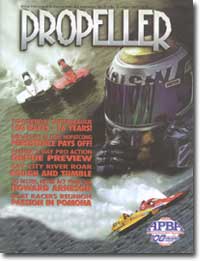
Howard Arneson
Innovator, sportsman, gentleman
"Go faster - and never act your age"
Story And Photos By Tony Wiese
Featured
in: Propeller
Volume 57 No. 8,
August 2003
Few racers or power boaters realize the impact Howard Arneson has had on racing
and the boating industry in general. Until Howard Arneson came along in the late
70 's and early 80's, the stern drive height (X dimension) was some 3 to 6 inches lower than today,
and speeds were 10-20% slower. Only when Arneson perfected the trimable and steerable
Arneson Surface Drive (ASD) did the surface drive have any major impact on racing
or pleasure boating.
Arneson has always been an innovator and inventor. One of his creations,
the Arneson Pool Sweep, not only made Howard wealthy but also created a whole new industry.
Today automatic pool cleaning is a multi-billion dollar industry annually. The Arneson Pool
Sweep was patented in the early 60's and he sold his company to Castle and Cook in 1969.
Howard then stayed with Castle and Cook for 12 years. After a brief retirement, he returned
to power boat racing and the development of his trimable and steerable Arneson Surface Drive (ASD).
Along the way he has also developed and patented many other marine and non-marine products.
Arneson retired from APBA Offshore racing as a driver and team co-owner
in the early 80's, after winning several championships. He also holds the New Orleans-to-St. Louis
speed record - 1039 miles up the Mississippi River in 12 hours. 40 minutes and 50 seconds at an
average speed of over 82mph. Today with his turbine powered boats Arneson continues to push the
envelope on power, boat design, drives, transmissions and propellers.
Few racers or power boaters realize the impact Howard Arneson has had
on racing and the boating industry in general. Until Howard Arneson came along in the late 70's
and early 80's, the stern drive height (X dimension) was some 3 to 6 inches lower than today,
and speeds were 10-20% slower. Only when Arneson perfected the trimable and steerable Arneson
Surface Drive (ASD) did the surface drive have any major impact on racing or pleasure boating.
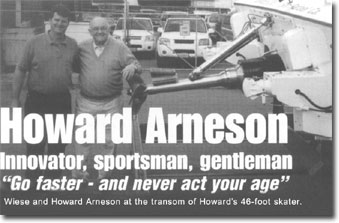 Arneson was also one of the first to work on multi-blade propeller technology. Running a
surface drive is hard on prop blades, and to finish a race, let alone win, you need all
of the propeller blades you started with. Prior to the development of the ASD, most racing
and sport boat propellers were 3 blades. With the increased pressure on the prop blades
caused by running a surface drive, 4-, 5-,and 6-blade propeller technology took off.
Arneson was also one of the first to work on multi-blade propeller technology. Running a
surface drive is hard on prop blades, and to finish a race, let alone win, you need all
of the propeller blades you started with. Prior to the development of the ASD, most racing
and sport boat propellers were 3 blades. With the increased pressure on the prop blades
caused by running a surface drive, 4-, 5-,and 6-blade propeller technology took off.
With more blades, the pressure on each blade is substantially reduced. On a 3-blade prop
each blade carries 33% of the load, and on a 5-blade prop each blade only carries 20% of
the load - a very substantial reduction. For years Arneson has worked closely with Rolla,
but always makes his own propeller modifications. Currently Arneson is running an innovative
and unique 5-blade cleaver style prop, thus continuing to push the envelope on propeller technology.
In the early 70's, Howard Arneson had bought a 36-foot Cigarette from Don Aronow, and then
had Dan Arena raise the deck and make an express cabin race boat. My father looked up Howard
to see the boat, as we were contemplating doing that as well. Arneson had also built a 38-foot
Arena Craft with fixed, straight drive shafts and conventional inboard rudders, such as Fabio
Buzzi does now. When I first met Arneson in the late 70's, he was racing the 38-foot
Scarab "SEA SWEEP" with that design.
During my visit in March, due to the war in Iraq going and the subsequent security measures
taken by the US military on the waters near San Francisco, we did not go out on his 46-foot
Skater ARNESON. Having been out on the boat several years ago, the only adjective to describe
it is "incredible". One of the many incredible things about the 46 was acceleration: we tested
0 to 100mph in 12 seconds flat - and we probably weighed in at around 14,000 tbs. On top of that,
at all speeds the 46 tracked like it was on rails. Since then the 46 has been completely re-rigged
and the Lycoming turbine fuel level increased to generate 4500hp rather than 3750hp. The turbine
is coupled to a modified #10 Arneson Surface Drive pushing a single, highly modified Rolla propeller.
The single engine in the 46-footer yields a simple and very compact setup as shown in the photos.
With re-rigging, the former top speed has become cruising speed. Having personally been in the
boat at a sustained 180mph, I can verify that it was rock solid. But, Arneson has no desire to
run the boat beyond 185mph. He has nothing to prove. He would rather test his ideas hour after
hour in the 100- 170 mph range. He is the single individual in the world with the most seat
time (over 1000 hours) at over 100mph in the various large Skaters.
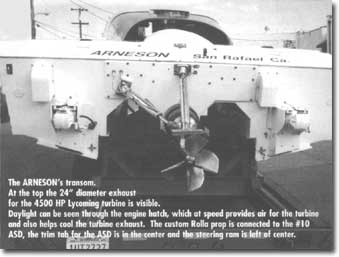 The 46 has been an ongoing project for seven years, but it is in better shape than most new boats.
Originally the 46 had a 3000hp Russian turbine. However, the Russian engine, although brand-new,
proved very unreliable (they cratered two of them) and so the switch was made to the more powerful
rebuilt Lycoming. Other than the Russian turbines, the units Arneson has used are rebuilt units that
are no longer FAA certifiable for airworthiness, typically purchased for about 10% of their original cost.
The 46 has been an ongoing project for seven years, but it is in better shape than most new boats.
Originally the 46 had a 3000hp Russian turbine. However, the Russian engine, although brand-new,
proved very unreliable (they cratered two of them) and so the switch was made to the more powerful
rebuilt Lycoming. Other than the Russian turbines, the units Arneson has used are rebuilt units that
are no longer FAA certifiable for airworthiness, typically purchased for about 10% of their original cost.
Over the years Arneson has redesigned the skeg and rudder for the Arneson Surface Drive to reduce
drag and torque, and to increase control. He also patented a trimable rocker plate that is installed
when a boat is built. A block is installed in the mold 1/2" thick x approx. 2' x 2', then an aluminum
plate is added in that space that can be raised 1/4" up or down to create rocker or hook in the hull.
These trimable rocker plates installed on all of his own boats allow exceptional control. His 46-footer
is the only Cat I've been on that stays level - there is no bow to the sky. It comes on -and off-plane level,
accelerates and decelerates level, with a rock-solid ride attitude. Arneson also developed trimable rocker
plates with the same capabilities as the molded-in units, but they are transom mounted for boats that were
not built with the other plates molded in.
Arneson Surface Drives were so successful in the early 80's that Kiekhaefer Aeromarine created
the K-Drive Stern Drive to compete with the ASD. After Mercury bought Kiekhaefer Aeromarine,
it became the Mercury #6 Drive. Even before the buyout, Mercury had a major development campaign
with the #4 drive (a shortened #3 drive) and the all new #5 drive (which was strong, but not
quite as strong as the K-Drive or the ASD).
Many have noted that the simplicity of the ASD is a natural for high horsepower applications.
The single drawback has been the inability to trim the drive up and lift the bow, particularly
for Cats, where the Mercury #4, #5 and #6 excel. However, trimable rocker plates and the bow
lift they provide, eliminate that drawback to the ASD.
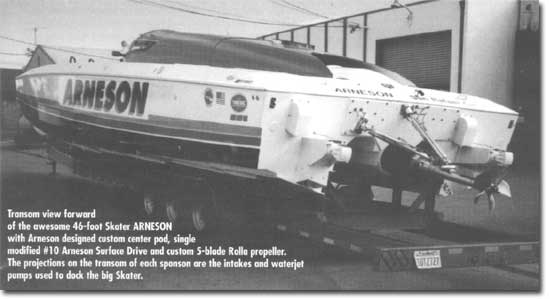
The ASD unit continues to have success in the gas engine performance boat market, but its
greatest impact in recent years has been in the high horsepower big diesel performance yachts.
The ASD reduces draft and improves speed, range and slow speed handling. Year after year at
the Miami and Fort Lauderdale boat shows the big Magnums, Pershings, Mangustas, etc. use ASD's.
And, because of their reliability, high-speed military and patrol craft worldwide also use the
ASD for the same reasons. When Sea Ray added ASD units to their 63-footer, they reportedly
added 15mph with no other changes vs. conventional shafts and rudders.
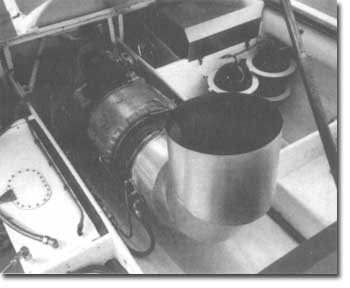 The engine compartment of the 46' Skater ARNESON. The 4500 HP Lycming turbine has the drive
shaft going toward the transom and the 24" exhaust facing forward toward the bow. This layout
provides the simplest, most reliable (no V-drive) and most compact engine compartment
configuration. The waterjet pumps for each spnson are in the stainless cases at the
top left and right.
The engine compartment of the 46' Skater ARNESON. The 4500 HP Lycming turbine has the drive
shaft going toward the transom and the 24" exhaust facing forward toward the bow. This layout
provides the simplest, most reliable (no V-drive) and most compact engine compartment
configuration. The waterjet pumps for each spnson are in the stainless cases at the
top left and right.
In May I had the opportunity for a sea trial in one of Magnum Marine's new 60-footers outfitted
with Arneson #12's along with one of the first pairs of V12 CAT 1550hp diesels in the US . The
Magnum tested was hull #5. The previous four 60-footers used the V16 MTU 1800hp engines, which
are several thousand pounds per engine heavier and some 4' longer. The reduced horsepower
yielded a slightly slower but much better balanced performance yacht.
The 60 Magnum (spinning 36-inch diameter 6 blade Rolla props with a 50-inch pitch and weighing
in at 70,000 pounds) hit 58.9mph. In the first sea trial, the 60 (some 6,000 lbs. lighter),
hit 60mph. Once the yacht is dialed in, Rolla and Magnum expect 62-63mph top speed with full
load. I was told the heavier V16 powered 60's are hitting 67mph. Because of the Magnum deep
vee hull design, Arneson drives and great weight balance, the 60 came right on plane with very
minimal bow lift, and carved turns sharply with grace and tenacity. With this setup you can cut
the wheel tight and hold on. The 60 cut through 3- to 5-foot seas gracefully, and was as nimble
as a 20' runabout. But first, he will probably go after the San
Experiencing the 46 Skater, and then the Magnum 60, helps bring home what an incredible product
Howard Arneson created in the ASD. He is also one of the most remarkable people I have ever had
the pleasure of calling a friend. One would never guess Howard is 82. His positive outlook,
constant energy and sheer enthusiasm for life and what he is doing are boundless. Howard Arneson
is a true innovator, sportsman, and one very exceptional gentleman. Howard, keep on inventing,
never act your age, and just go faster! Twin Disc manufactures the Arneson Surface Drives.
To subscribe to this fine
magazine contact:
American Power Boat Association
17640 East Nine Mile Rd
Eastpointe, MI 48021-0377
Phone: (586) 773-9700
Fax: (586) 773-6490
Web:
http://www.apba-racing.com
|
Arneson
Industries
Rare
"Classified"
Photo
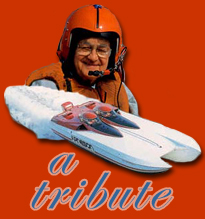 |